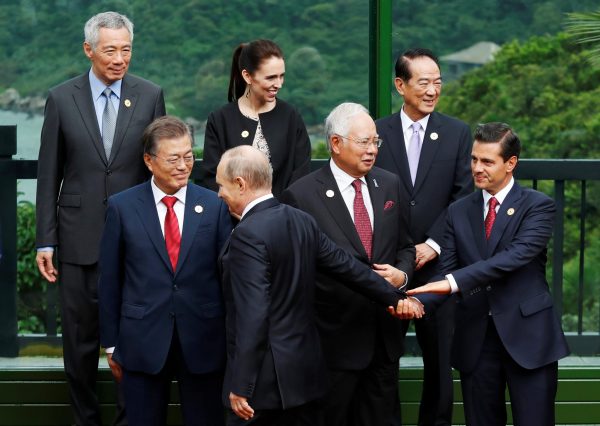The deal was renamed the ‘Comprehensive and Progressive Agreement for Trans-Pacific Partnership’ (CPTPP) to reflect the new consensus that had emerged after four rounds of negotiations since the United States’ withdrawal.
So is the CPTPP still a high-quality agreement and will it be finally ratified this time around?
While the details are yet to be worked out, the joint ministerial statement and its annexes suggest that the CPTPP will essentially be a replica of the original TPP.
Commitments to liberalise in key areas such as textiles, technical barriers to trade, sanitary and phytosanitary measures, competition, state-owned enterprises, labour and dispute settlements are still intact.
But the CPTPP differs from the TPP in two ways. First, it suspends 20 provisions from various chapters of the TPP. These rules (which were inserted at Washington’s insistence) have been put on hold for now but could be reinstated at a future date.
Notably, the chapter on intellectual property has undergone the most significant change. For example, the duration of copyright protection has been reduced from 70 to 50 years after the demise of the creator.
Second, as opposed to the neoliberal thinking on free trade that was embedded in the TPP, the CPTPP notes that in policymaking, member states should first and foremost consider their own changing ‘country-specific’ circumstances. Enhanced policy space and regulatory flexibility will be incorporated in the new articles on ‘withdrawal’, ‘accession’ and ‘review’ that are to be drafted.
Currently, Malaysia wants a longer transition period before stringent competition rules are applied to its state-owned enterprises. Vietnam seeks more time before its nascent trade unions are subjected to dispute settlement measures. And Canada wants to protect its politically sensitive cultural and broadcasting industries.
Some believe that without the United States, the TPP is a meaningless deal. This is because the United States accounted for 60 per cent of the former TPP bloc’s combined GDP. But our simulation results using the advanced multi-region, multi-sector Global Trade Analysis Project (GTAP) model suggest otherwise.
Estimates show that the net benefit of CPTPP to all its members from liberalisation of trade in goods and services is roughly 0.3 per cent of their combined GDP (equivalent to US$37.3 billion) in the medium-term. The CPTPP will also add US$21 billion to global welfare. These benefits will increase as membership expands and the dynamic benefits from trade liberalisation are realised over time.
All 11 members will be better off with the CPTPP than without it. Among the Asian members, Malaysia will gain the most (2 per cent of GDP), followed by Vietnam and Brunei (with 1.5 per cent each) and New Zealand and Singapore (with 1 per cent each). In Latin America, Mexico and Chile will gain relatively more than surrounding countries (0.4 per cent each).
Although the CPTPP has been agreed upon in principle at the ministerial level, it is yet to be ratified. This will require legislative actions in all member countries. The process is likely to be relatively straightforward except in Canada, which faces a bit of a dilemma. The country is concerned that pressing ahead with a deal despised by Trump could impact adversely on the ongoing negotiations of the North American Free Trade Agreement (NAFTA). That is perhaps why the country did not participate in one of the meetings in Vietnam. But a revamped CPTPP could paradoxically serve as an insurance policy against the potential breakdown of NAFTA renegotiations.
The revised ratification rule could also help in this regard. The CPTPP has removed the 85 per cent cumulative GDP threshold requirement for TPP ratification by stipulating that the deal could be triggered once six out of the eleven members complete their domestic ratification process, regardless of the cumulative GDP.
Going forward, the interest of several aspirant countries such as Colombia, Indonesia, Taiwan and Thailand to join the trade pact should be actively encouraged to knock down trade barriers in those economies. The United States may even wish to come back once Trump leaves the White House and sanity returns to Washington’s trade policy.
Pradumna B Rana is Associate Professor and Coordinator of the International Political Economy Programme in the Centre for Multilateralism Studies (CMS) at the S. Rajaratnam School of International Studies (RSIS), Nanyang Technological University, Singapore and Ji Xianbai is a PhD candidate at RSIS, and formerly Europa Visiting Fellow at the Australian National University Centre for European Studies (ANUCES)
This article was first published here in RSIS.

